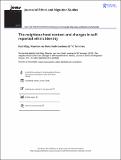Files in this item
The neighbourhood context and changes in self-reported ethnic identity
Item metadata
| dc.contributor.author | Mägi, Kadi | |
| dc.contributor.author | van Ham, Maarten | |
| dc.contributor.author | Leetmaa, Kadri | |
| dc.contributor.author | Tammaru, Tiit | |
| dc.date.accessioned | 2018-12-04T15:30:15Z | |
| dc.date.available | 2018-12-04T15:30:15Z | |
| dc.date.issued | 2018-11-25 | |
| dc.identifier | 256459602 | |
| dc.identifier | 01fe41aa-5bb9-486b-9273-28f700505680 | |
| dc.identifier | 85057294744 | |
| dc.identifier.citation | Mägi , K , van Ham , M , Leetmaa , K & Tammaru , T 2018 , ' The neighbourhood context and changes in self-reported ethnic identity ' , Journal of Ethnic and Migration Studies , vol. Latest Articles . https://doi.org/10.1080/1369183X.2018.1547634 | en |
| dc.identifier.issn | 1369-183X | |
| dc.identifier.other | ORCID: /0000-0002-2106-0702/work/64697522 | |
| dc.identifier.uri | https://hdl.handle.net/10023/16622 | |
| dc.description | This work was supported by the European Research Council under the European Union's Seventh Framework Program (FP/2007-2013) / ERC Grant Agreement n. 615159 (ERC Consolidator Grant DEPRIVEDHOODS, Socio-spatial inequality, deprived neighbourhoods, and neighbourhood effects) and the Institutional Research Grant No. IUT2-17 of the Ministry of Education and Science Estonia. | en |
| dc.description.abstract | Although many studies claim that the residential context is an important factor in shaping the ethnic identity of minorities, there are few studies which actually measure this relationship. This study contributes to filling this gap by investigating the relationship between the ethnic composition of neighbourhoods and changes in the self-reported ethnic identity of Russian-speaking minorities living in post-Soviet Estonia. Additionally, we observe Estonians who have changed their ethnic identity to Russian. We used data from the 2000 and 2011 Estonian censuses, which were geo-coded and linked at the individual level, enabling us to follow individuals over time. We estimated multi-level and fixed effects regression models to explore the relationship between the neighbourhood context and changes in ethnic identity. The main results show that ethnic minorities who live in majority-dominated neighbourhoods and regions, are the most likely to change their ethnic identity. We also show that members of the majority population who live in minority-dense neighbourhoods are more likely to change their ethnic identity than other majority group members. The results suggest that opportunities to meet people from other ethnic groups are important in processes of integration and assimilation, and it affects members of the majority and minority population alike. | |
| dc.format.extent | 20 | |
| dc.format.extent | 2196810 | |
| dc.language.iso | eng | |
| dc.relation.ispartof | Journal of Ethnic and Migration Studies | en |
| dc.subject | Ethnic identity | en |
| dc.subject | Ethnic segregation | en |
| dc.subject | Acculturation | en |
| dc.subject | Assimilation | en |
| dc.subject | Integration | en |
| dc.subject | HT Communities. Classes. Races | en |
| dc.subject | 3rd-DAS | en |
| dc.subject.lcc | HT | en |
| dc.title | The neighbourhood context and changes in self-reported ethnic identity | en |
| dc.type | Journal article | en |
| dc.contributor.sponsor | European Research Council | en |
| dc.contributor.institution | University of St Andrews. School of Geography & Sustainable Development | en |
| dc.identifier.doi | 10.1080/1369183X.2018.1547634 | |
| dc.description.status | Peer reviewed | en |
| dc.identifier.grantnumber | ERC-2013-CoG | en |
This item appears in the following Collection(s)
Items in the St Andrews Research Repository are protected by copyright, with all rights reserved, unless otherwise indicated.

